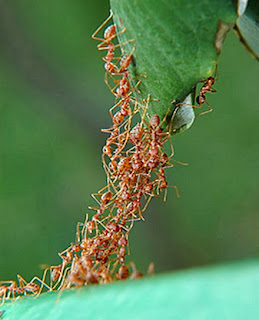
Characteristics of an Intelligent Swarm
- A swarm operates without any centralized control. No single ant rules the colony or tells all the other ants what to do. (All the queen ant does is lay eggs.)
- Swarms cannot see the whole of their environment... However, an ant can see things in its immediate presence, and the ant can tell other ants some basic pieces of information about its environment (like "follow this trail to food" or "there is danger here"). They can build up a dynamic, real-time map of the environment very quickly (call this an ant's version of spiritual mapping).
- Swarms can change their environment. They can dig tunnels, shift sand, build up structures and adapt the land for their own use. They can build communities that are miles long—ant-like subways, apartments and 7-Elevens.
- Swarms capitalize on randomness. It may seem like a mistake for an ant to go off wandering and not find any food. But this is their form of spontaneous creativity: a random action can open up new possibilities. It increases the chances that they will find something. They are not bound to a central plan that might fail in the face of an unforeseen problem.
- Swarms are very flexible. They can adapt to changing situations. Ants can cooperate to carry off large items and sort them. If they encounter more food, they can build extensions on their nest to store it. If there are too many predators in an area, they can migrate.
- Ant swarms endure. Worker ants protect the hive, and in some cases swarming ants can kill creatures far larger than themselves.
1 comment:
If you would like to do an independent study....stop by my apartment sometime. They seem to be planning a take over or something.
Also I have learned that a few ants do not ruin a cake for Micronesians. There's always plenty to share even with bugs apparently.
Post a Comment